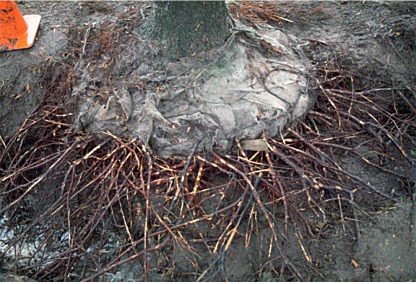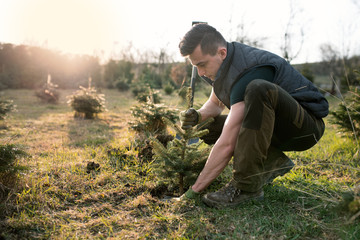
Introduction to Tree Planting

Think of the tree you purchased as a lifetime investment. How well your tree and investment grows depends on the type of tree and location selected for planting, the care provided when the tree is planted, and the follow-up care the tree receives after planting, through the early years.
You can find out more about species, location, and caring for trees on our Tree Selection and Tree Care pages.
The ideal time to plant trees and shrubs is during the dormant season. In the autumn after leaf drop, or early spring before bud-break. Weather conditions are cool and allow trees to establish roots in the new location, before spring rains and summer heat stimulate new top growth.

Container-grown trees properly cared for in the nursery or garden centre, given the appropriate care during transport to prevent damage, can be planted throughout the growing season. Proper handling during planting is essential to ensure a healthy future for new trees and shrubs. Before you begin planting your tree, be sure you have had all underground utilities located prior to digging.

If the tree you are planting is root-balled or bare rooted, it’s important to know that the tree’s root system has been reduced by 90-95% of its original size during transplanting. As a result of the trauma caused by the digging process, trees will exhibit what is known as transplant shock.
Trees in containers may also experience transplant shock, particularly if they have circling roots that must be cut. Transplant shock is indicated by slow growth and reduced vigour following transplanting. Proper site preparation before and during planting, coupled with good follow-up care, reduces the amount of time the plant experiences transplant shock, and allows the tree to quickly establish in its new location. Carefully follow the nine simple steps below, and you can significantly reduce the stress placed on the plant during planting.



It’s better to put a £100 tree in a £200 hole than a £200 tree in a £100 hole.
Ian McDermott

A Step-by-Step Guide to Tree Planting
Step 1: Dig a shallow, broad planting hole

Make the hole wide, as much as three times the diameter of the root ball but only as deep as the root ball. It is important to make the hole wide because the roots on the newly establishing tree must push through surrounding soil in order to establish.
On most planting sites in new developments, the existing soils have been compacted and are unsuitable for healthy root growth. Breaking up the soil in a large area around the tree provides the newly emerging roots room to expand into loose soil to hasten establishment. Don’t forget to check overhead – if the canopy would grow into cable or other obstructions, it may be better to find a more suitable location before you begin.
Step 2: Identify the trunk flare

The trunk flare is where the roots spread at the base of the tree. The flare should be partially visible after the tree has been planted (see diagram, left). If the trunk flare is not partially visible, you may have to remove some soil from the top of the root ball, so you can find it to determine how deep the hole should be for proper planting for a healthy tree.
Step 3: Remove tree container for containerised trees
Carefully cutting down the sides of the container may make this easier. Inspect the outer area of the root ball for circling roots and cut or remove them. In extreme cases of root girdling, you are advised to reject the tree. Expose the trunk flare, if necessary.

This is what happens when plastic burlap is not removed, that’s why this method is not recommended, source:
Root growth and wire baskets

Step 4: Place the tree at the proper height
Before placing the tree in the hole, check to see that the hole has been dug to the proper depth, but no more. The majority of the roots on the newly planted tree will develop in the top 30cm of soil. When the tree is planted too deeply, new roots have difficulty developing due to a lack of oxygen.

It is better to plant the tree a little high, 5 to 7.5cm inches above the base of the trunk flare, than to plant it at or below the original growing level. This planting level will allow for some settling. To avoid damage when setting the tree in the hole, always lift the tree by the root ball, and never by the trunk. This photo depicts a hole that is far too deep to sustain the tree, source: Tree too deep
Step 5: Straighten the tree
Before you begin backfilling the hole, have someone view the tree from several directions to confirm that the tree is straight. Once you begin backfilling, it is hard to reposition the tree in the hole.

Step 6: Fill the hole gently but firmly
Fill the hole about one-third full and gently but firmly pack the soil around the base of the root ball. If the root ball is wrapped, cut and remove any fabric, plastic, string, and wire from around the trunk and root ball to facilitate growth (see basket diagram below, source: Root growth and wire baskets). Be careful not to damage the trunk or roots in the process.
Fill the remainder of the hole, taking care to firmly pack soil to eliminate air pockets that may cause roots to dry out. To avoid this problem, add the soil a few centimetres at a time and settle with water. Continue this process until the hole is filled and the tree is firmly planted. It is not recommended to apply fertiliser at the time of planting.
Step 7: Stake the tree (if necessary)

If the tree is grown and dug properly at the nursery, staking for support will not be necessary in most home landscape situations. Studies have shown that trees establish more quickly and develop stronger trunk and root systems if they are not staked at the time of planting.
Protective staking may be required on sites where lawn mower damage, vandalism, or windy conditions are concerns. If staking is necessary for support, there are a number of methods to choose from: staking, guying, and root ball stabilisation (underground guying).
One of the most common methods for stability during early years is staking. With this method, one, two, or even three stakes are used in conjunction with a wide, flexible tie material on the lower half of the tree, to hold the tree upright, provide flexibility, and minimise injury to the trunk (see mulching and staking diagram below). Do not drive stakes through the root ball. Remove support staking and ties after the first one to two years of growth.
Step 8: Mulch the base of the tree
Mulch is organic matter applied to the area at the base of the tree, and it acts as a blanket to hold in moisture, it moderates soil temperature extremes, and it reduces competition from grass and weeds.

Some good choices are leaf litter, shredded bark, composted wood chips, and composted garden waste. A 5 to 10cm layer is ideal. More than 10cm may cause a problem with oxygen and moisture levels.
When placing mulch, the actual trunk of the tree should not be covered. Doing so may cause decay of the living bark at the base of the tree. A mulch-free area, 2.5 to 5cm wide at the base of the tree, is sufficient to avoid moist bark conditions and prevent decay. See the images below depicting good, bad, and the results of bad mulching, source: Mulch can damage trees.



Step 9: Follow-up care
Keep the soil moist but not soaked; over-watering causes leaves to turn yellow or fall off. Water trees at least once a week, barring rain, and more frequently during hot weather. When the soil is dry below the surface of the mulch, it is time to water. Continue until mid-autumn, tapering off for lower temperatures that require less-frequent watering.

Minor pruning of branches damaged during the planting process may be necessary for the newly-planted tree’s follow-up care. Prune sparingly immediately after planting, and wait to begin necessary formative pruning until after a full season of growth in the new location.

Final Words

After you have completed these nine simple steps, further routine care coupled with favourable weather conditions will ensure that your new tree will thrive. A valuable asset to any landscape, trees provide a long-lasting source of beauty and enjoyment for people of all ages.
If you have any questions about your new tree please ask us,
or alternatively a tree care or nursery/garden centre professional.

